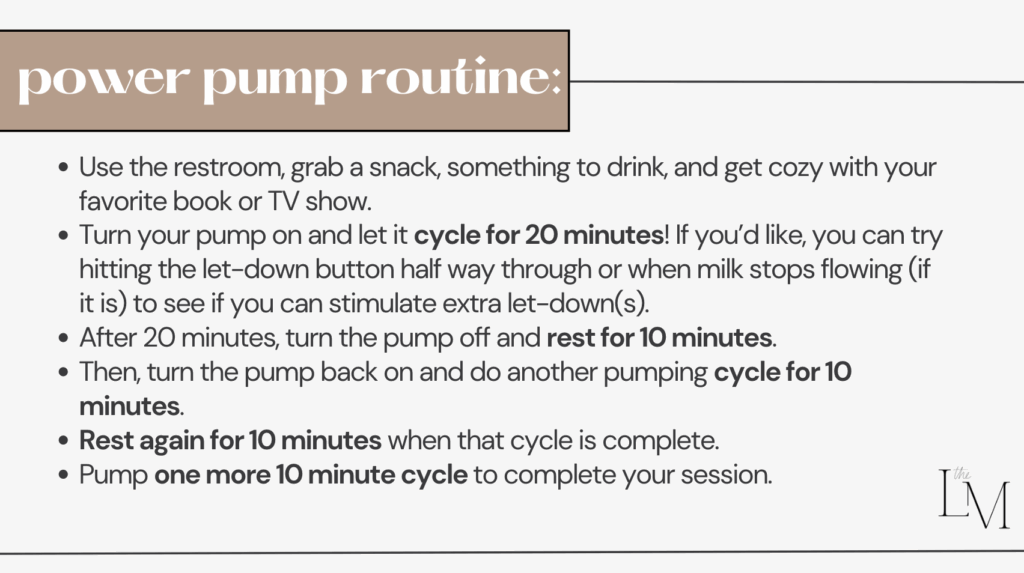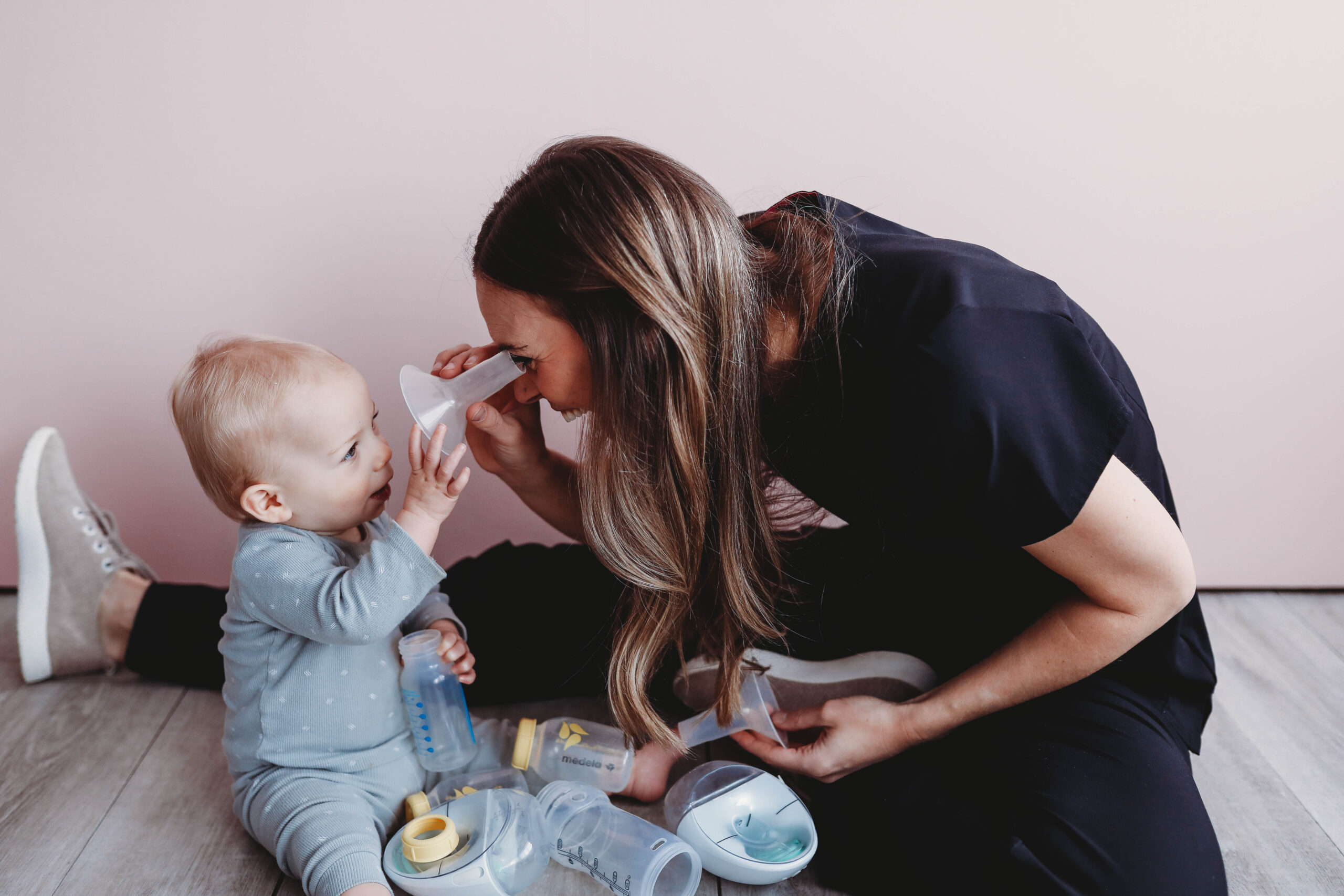Increasing your milk supply can be a challenge for many breastfeeding mamas. While there are lots of different strategies to boost milk production, one specific practice that has proven effective for some is power pumping. This technique is pretty low risk – it doesn’t include supplements or things you’re supposed to eat and it utilizes the pump you very likely already have!
This pumping technique mimics a baby cluster feeding, which is those times when your baby keeps coming off and on the breast, frequently asking for more and more from your body. In those hours (or days) yYou might feel like you’re not getting a great break, but this increased, frequent demand can signal your body to produce more milk. This is what you’re trying to do when you attempt power pumping!
If you’re ready to dive into power pumping for low milk supply, then you’re in the right place!
Here’s what we’ll cover:
- What is power pumping?
- When to power pump
- How to power pump
- How long to power pump
- Managing expectations
- Tips for power pumping
- Equipment you’ll need
- Pumps I’ve used & loved for power pumping
- Favorite pumping bras
What is Power Pumping?
Power pumping is an intensive pumping routine designed to stimulate milk production by mimicking a baby’s cluster feeding. This practice involves a series of pumping and resting intervals within an hour-long session. It’s something you would add to your regular pumping or breastfeeding routine, rather than replacing any sessions. Typically, you would power pump one time a day.
When to Power Pump
Due to the time commitment, many moms choose to power pump in the evenings once their baby is asleep. This is also when babies commonly cluster feed. However, you can do it whenever it suits your schedule best. The key is consistency—choose a time when you can regularly commit to this routine.
If you’re an exclusive pumper, you could also consider turning one of your normal pumping sessions into a power pumping session (which of course means it’d be much longer than your “normal” session).
How to Power Pump
Here’s a step-by-step guide to power pumping:
- Prepare Yourself: Before you start, use the restroom, grab a snack, something to drink, and get comfortable with your favorite book or TV show. Remember, this session will take about an hour.
- Start Pumping: Turn on your pump and let it cycle for 20 minutes. If you’d like, you can try hitting the let-down button halfway through or when milk stops flowing to stimulate additional let-downs. Other tricks to encourage let-downs include watching videos or looking at pictures of your baby or applying warm compresses to your breasts. Some gentle massage may help the milk flow too.
- First Break: After 20 minutes of pumping, turn the pump off and rest for 10 minutes. Use this time to relax and hydrate.
- Second Cycle: Turn the pump back on for another 10 minute pumping session.
- Second Break: Rest for another 10 minutes.
- Final Cycle: Finish with one more 10 minute pumping session.
How Long to Power Pump
The cycle I just shared with you utilizes really clean numbers, 20 minutes and 10 minutes, and totals an hour. But if you just do not have that amount of time once a day, you can cut that back! For instance, you could start with 10 minutes on and then 5 off and on or 12 minutes on and then 8 off and on. Like I mentioned initially, you just want to be consistent each day!

Managing Expectations
It’s important to manage your expectations when you starting power pumping. Your initial sessions might not yield a significant amount of milk, and that’s perfectly normal. The goal of power pumping is to provide your body with the stimulation needed to signal increased milk production. With consistent practice, some mothers notice an increase in their milk supply within a few days, while for others, it might take a week or so. If you’re seeing no change around the week mark and you have an LC who is part of your journey, I’d suggest reaching out to them about your current plan and any changes you may want to make in a couple of weeks.
Tips for Power Pumping
Pumping—especially power pumping—can be quite exhausting. A bit of advance planning can help you feel your best and ensure your sessions are as productive as possible. Try to:
- Keep Hydrated: Drink plenty of water before you begin and continue to sip throughout the day.
- Nourish Yourself: Nursing moms need a lot of nutrition, so keep healthy snacks within reach and don’t skip meals.
- Rely on Your Support Network: If you can schedule a power pumping session during your baby’s long nap, great! If that’s not possible, arrange for someone else to care for your little one so you can pump without interruptions. Even better: Try to get a bit of rest before you start pumping.
- Facilitate Your Let-Down: Looking at pictures of your baby or even just thinking about cuddling them right before you pump can help get the milk flowing. Applying a warm compress to your breasts for five to ten minutes, taking a hot shower, or massaging your breasts can also be beneficial.
- Treat Yourself: Watch a favorite TV show, read a book, or do something else that’s enjoyable and relaxing while you pump. You deserve it.
- Ensure Your Pump Fits Well: Pumping shouldn’t be painful. If you’re experiencing discomfort, your pump’s flange might be the wrong size, so consider trying a different size. If it’s still uncomfortable, consulting a lactation specialist may help troubleshoot the issue.
- Don’t Overdo It: If you don’t have the energy for power pumping one day or would prefer to relax, don’t force it. More breast milk is great for your baby, but getting enough rest and taking care of yourself is equally important.
Equipment You’ll Need for Power Pumping
For power pumping, the best tool is a double-electric pump. This type of pump allows you to pump both breasts simultaneously, making the process more efficient. If you only have a manual (hand) pump, you can use that! You would want to alternate between right and left (for example 10 and 10 minutes, then 8 and 8 minutes, then 8 and 8 minutes) for about an hour. Technically, your hand doesn’t get a break with this plan, so yes, you can take one between cycles when you need to!
Pumps I’ve Used & Loved For Power Pumping
When it comes to pumping (and any power pumping you want to try), I’ve tried quite a few styles of pumps, including the larger, plug-in style double electrics (like medela and spectra), portable styles like Pumpables, and wearables like Elvie and MomCozy.
Plug In Style Double Electrics
Portables
Wireless/Wearables
I’m someone who absolutely loves wearables (also meaning wireless/tubeless), but one complaint or downside for many is that this style pump does not pull as much milk as other options. So most do not choose a wearable as their primary pump. (That’s really good advice – don’t skip it).
Personally, I do not have that issue and use the Eufy and Momcozy often (but I am not an exclusive pumper)! This is the Momcozy M5 I have and am using a ton with baby #4. And then this is the Eufy S1 Pro I am using and love as well. Honestly, I have had great success with both and have written up thoughts for you to check out both here.
If you want to stay away from wireless but would still like some portability, I’d suggest looking at the Pumpables GA or the Baby Buddha. Both of these pumps still have tubing, but the battery pack is small, can be worn or clipped to your clothes (aka – you’re mobile!) and they are usually just as efficient as pumps like the Medela or Spectra double electric! Many of us choose to use pumps like the pumpables or the baby buddha as a primary pump; I get the same amount of milk with those as I do with my Medela!
Of course, you don’t need a portable or a wireless to pump (or power pump)! The classic double electrics (usually covered by insurance) work great and for many, that’s the only pump they use throughout their journey.
Favorite Pumping Bras
For my wearables (which can be a little heavy), I love this Auden bra and this 5-pack of nursing bras from Amazon. Both styles do great at holding the wearable nice and snug so there is no leaking. The Auden pads are not removable (which I love), while the Suekaphin 5-pack ones are removable.
For pumps with tubing, I like the Kindred Bravely Sublime pumping bra and Bodily’s Do Anything.
– Kindred Bravely Sublime: Be sure to use the code LABORMAMA15 to save 15%
– Bodily’s Do Anything Bra: LO15 *might save you 15% on orders of $125 or more – try it!
Final Thoughts on Power Pumping To Increase Low Milk Supply
Power pumping can be a valuable tool in your breastfeeding journey. It requires time and consistency but can lead to increased milk supply by mimicking your baby’s natural feeding patterns. Remember to stay hydrated, well-nourished, and relaxed during your sessions.
By incorporating power pumping into your routine, you’re taking proactive steps to support your milk supply, giving you and your baby the best chance for a successful breastfeeding experience.
However, I know that breastfeeding isn’t always easy. You’ve probably heard a ton of stories about how hard breastfeeding is – and I’m glad. Because it’s important to be honest about the fact that something so good does often come with challenges!
But we can hear those stories and feel scared or we can hear those stories and get informed. Knowing how this all works, knowing how to correct any bumps in the road, knowing that there are answers to the questions that will almost certainly come up – that’s the game changer.
Having support, knowledge and education like that can change everything.
That’s why I’ve created The Breastfeeding Blueprint, so that you have all of the knowledge at your fingertips instead of scrolling through Google at 2am. I am here for you – let’s do this!
Have you tried or thought about trying power pumping before? I would love to hear how your experience went, feel free to ask any questions in the comments! xx, Lo
Loved this blog post? Here’s some others you’ll probably like:
- Understanding & Dealing With Postpartum Engorgement
- The Best Lactation Cookies & Energy Bites For Milk Supply
- How To Build A Breastmilk Freezer Stash
More resources (and freebies!) for you to take a peek at:





